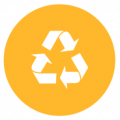Sorted waste
 Waste
Waste
Plastics
The yellow containers are for plastics (PET bottles, plastic sheets, empty plastic containers) and also for drinks cartons (milk and juice containers) and metal packaging (cans for food, drinks or cosmetics). Yellow containers are NOT for PVC materials or containers that were used for hazardous substances!
These containers are located at around 1 400 points within the city (within 100 metres of high-density residential areas and 200 metres of low-density areas). These types of waste are collected together in order to reduce the costs of collection and the negative environmental impact of collection). A sorting line is then used to separate the individual types of plastics and plastic packaging, drinks cartons and metal packaging.
In 2015 a total 3 510 t of plastics were collected in this way (a further 104 at recycling centres). The recyclable material is then sold to processers; some material is used to produce alternative fuels. Of the waste sorted on the lines, 26% is used for material recycling, and 64% is used for energy generation. The remaining approx. 10% is not suitable for these purposes, and it is deposited as landfill.
Paper
The blue containers are for paper (newspapers, magazines, leaflets, cardboard boxes, etc.). They should not be wet, greasy or dirty.
Paper is collected similarly to plastics and also via scrap paper collection centres and scrap paper collection campaigns in schools (supporting environmental education).
In 2015 a total 2 657 t of paper was collected in coloured containers, 6 325 at collection centres, and under 100 t via schools. 100% of the separately collected paper is used for recycling.
Glass
Glass (bottles, jars, and broken glass) is collected in bottle banks (both clear and coloured glass together). They are not for porcelain, pottery, glass from cars, wire-reinforced glass, or mirrors. There are also several underground bottle banks in Ostrava.
All 1 100 bottle banks in the city are located within 100 metres of high-density residential areas and 2 500 metres of low-density areas.
In 2015 a total 2 654 tonnes of glass were collected. The glass is taken to the sorting facility, where it is sorted by colour and unwanted additional material is removed (usually up to 5% of the total volume). The separated glass is then supplied to glassworks for recycling.
Organic (garden) waste
Garden waste comes from two main sources – either from City-owned green areas or privately owned gardens. Households with gardens can use special garden waste bins (brown colour) provided by the City. In 2016 the City supplied these 240-litre bins to households on request (free of charge). Householders can also use recycling centres, which have special containers for garden waste. The third collection system involves providing large skips (at the request of the municipal districts) at locations where greenery maintenance is planned.
In 2015 a total 1 057 t of garden waste were collected at garden waste bins. 2015 was a relatively dry year; this led to a reduction in the volume of garden waste (normal annual volumes range from 10 000 – 15 000 tons). Most garden waste is taken to the OZO composting centre, where it is processed to produce compost and substrate.
Electrical appliances
There’s a very easy way of disposing of old electrical appliances – when you buy a new one, the store will simply take back your old one for you. Manufacturers of household appliances (including fridges) are legally responsible for the ecological disposal and takeback of their products. Another easy way to dispose of old appliances is by taking them to one of Ostrava’s recycling centres. If this isn’t convenient, citizens can use the city’s skip collection service or phone to book a collection direct from their homes.


